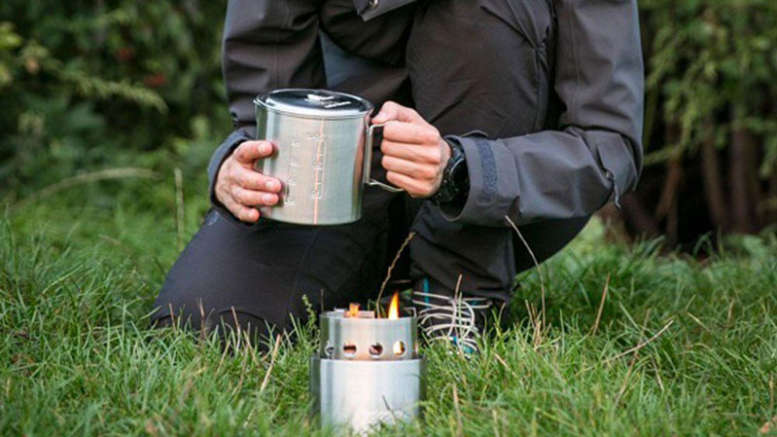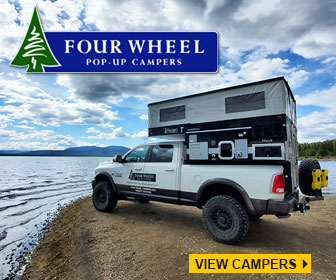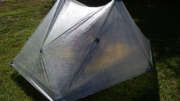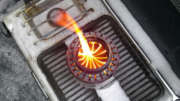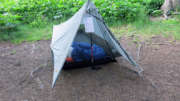If you’re headed out on a backpacking adventure, you have two basic choices about how you’re going to cook your food other than the traditional campfire. You can cook on a canister stove like the JetBoil or the MSR Reactor. Both are excellent stoves. Those two backpacking stoves and other similar canister stoves are well reviewed by some of the top gear evaluation websites. Or, you can choose a wood burning backpacking stove like the Solo, the Emberlit, the Silverfire Scout, or one of the other similar stoves profiled below. With a wood burning backpacking stove, you build a fire with twigs or branches or frugal amounts or some other combustible inside a small fire chamber. Air is drawn up through holes in bottom of the stove and flows through the fire chamber, creating an intense heat on the bottom of the cooking vessel.
Both categories of backpacking stoves – canister and wood burning have their advantages and disadvantages. But from a purely subjective point of view, the wood burning backpacking stove may be the purest form of environmentally friendly cooking while backpacking there is. Cooking with a fire, even though it is a small one like these stoves provide, is an elemental component of being outdoors. It ads warmth, comfort, friendliness, and a direct connection to the primitive world that we are all seeking by backpacking in the wilderness in the first place.
In addition to those intangible qualities that wood burning backpacking stoves bring to the backpacking experience, they have some specific practical advantages as well.
- WEIGHT. They are light and packable. The Emberlit stove, for example, weighs just 11.3 ounces, folds down flat to 1/8” and will fit in a ziplock bag. Wood burning stoves are a great option for lightweight backpacking.
- FUEL. You don’t have to carry any type of fuel with you when you go backpacking. No fuel canisters to buy and pack. Wood burning backpacking stoves burn astonishingly small amounts of just about anything combustible that can picked up around your campsite or on the trail leading up to camp, pine cones and twigs are just two examples.
- SIMPLICITY. There’s nothing to adjust or maintain on a wood burning backpacking stove.
- COOKING SPEED. The cooking speed is comparable with cannister stoves. In one side-by-side test a Jetboil canister stove boiled water in 1 minute 18 seconds, while a wood burning backpacking stove took 1 minute 30 seconds, although, as a general rule, wood burning backpacking stoves take a little longer to boil water than canister stoves, sometimes 4 minutes or more. Cooking speed is directly related to the surface area of the cooking vessel. A flat pan heats water faster than a cylindrical container with a narrow diameter. Cooking speed is specified in the summaries of all the stoves below when it is available.
- ENVIRONMENTAL IMPACT. Wood burning backpacking stoves require only a small amount of wood and have a much lower environmental impact than a campfire. The best wood burning stoves burn fuel completely to ash which is easily buried, leaving no trace.
There are some disadvantages to be sure.
- Wood burning backpacking stoves are not as neat as canister stoves– you’ve got smoke, soot, and ashes to contend with.
- Heavy rain will have an impact on your fuel. It’s not a bad idea to take along a small backup supply of Esbit fuel tablets or a Trangia Alcohol Burner, or a similar fuel source.
But with that said, a wood burning backpacking stove will enhance your connection to the outdoors and provide a soul-satisfying method of preparing your backpacking meals.
Here are summaries of the six top rated wood burning backpacking stoves with highlights of the most distinguishing features of each one. Note when reviewing these summaries that there are two basic designs: cylinder stoves where the parts fit inside each other and are packed in a small carrying bag; and folding or collapsible stoves that fold or collapse down flat. These two types are specified in the descriptions and are clear from the accompanying photos. In both types of stoves, holes along the bottom allow air to flow in and up through the combustion chamber generating intense heat.
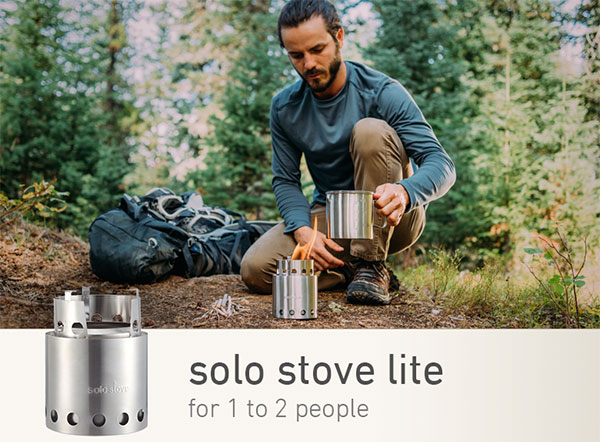
Solo Stove Lite – Compact Wood Burning Backpacking Stove
- Weight: 9 ounces
- Dimensions: 4.25” x 3.8” x 3.8”
- Type: Circular double wall design
Distinguishing Characteristics: The stove features a double wall design that allows fuel to burn more efficiently and with less smoke thanks to a process called “gasification.” It has a heat shield that prevents the ground under the stove from being scorched, an important Leave No Trace feature particularly if you’re camping in pristine locations.

Emberlit Wood Stove
- Weight: 11.3 ounces
- Dimensions: 5” x 5” x 6”; packs flat to 1/8”
- Type: Collapsible, stainless steel
- Boils Water in: 10 minutes
Distinguishing Characteristics: The Emberlit is a compact, lightweight wood burning stove that produces an even flame with little smoke. The stove is is sturdy when assembled and stable when sitting on a level surface. Packs flat about 1/8” thick.
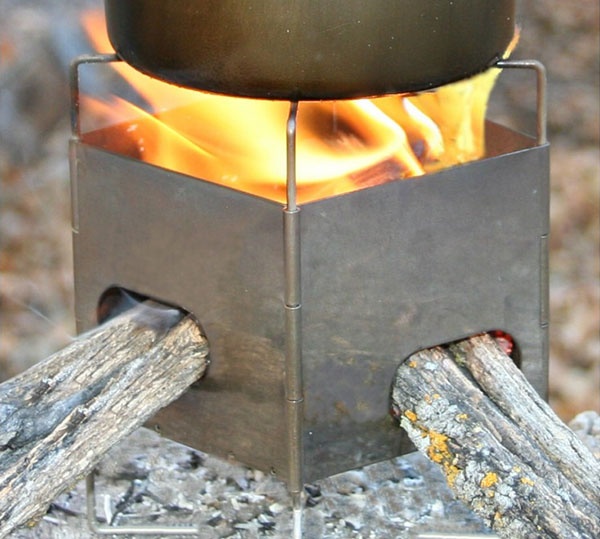
Gen 2 Folding Firebox Nano Ultralight Backpacking 3” Stove
- Weight: 5.6 ounces
- Dimensions: 3” x 4.75”; folds down to .25”
- Type: Hinged folding stove
- Boils Water in: Boils 2 cups of water in just over 3 minutes
Distinguishing Characteristics: The Nano is based on the principle that if you cross the sticks inside the combustion chamber it will produce a hotter fire with less smoke. It has two feed portals so that you can fuel the fire from 2 sides. The pot stand is adjustable so that it will accommodate different size pots.The legs are attached to the pot stand so they adjust at the same time creating a larger footprint for the stove. Thick stainless steel construction prevents warping. The stove is also capable of using a Trangia Alcohol Burner. Just drop it into combustion chamber, the same place the wood goes.
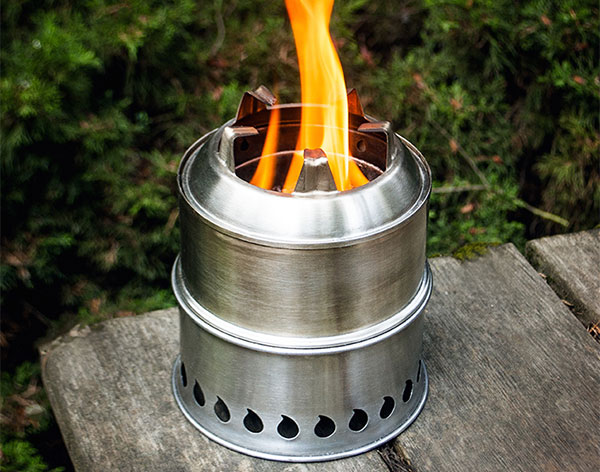
SilverFire Scout Backpack Bug Out Bag Gasifier Twig Stove
- Weight: 12 ounces
- Dimensions: 6.75” tall x 5” in diameter assembled, 2.5” tall collapsed
- Type: Cylindrical Design
Distinguishing Characteristics: A stainless steel, double-walled combustion chamber produces something called “gasification” meaning that, in effect, the stove burns the fuel twice, increasing the amount of heat and ensuring that the fuel will burn completely leaving little ash. An ash plate catches any live embers. The stove has a very compact footprint. On the downside, you feed the fire from the top, meaning that you have to remove the cooking vessel from the stove in order to add fuel, whereas the other stoves listed here have one or two fuel feeding portal in the side.
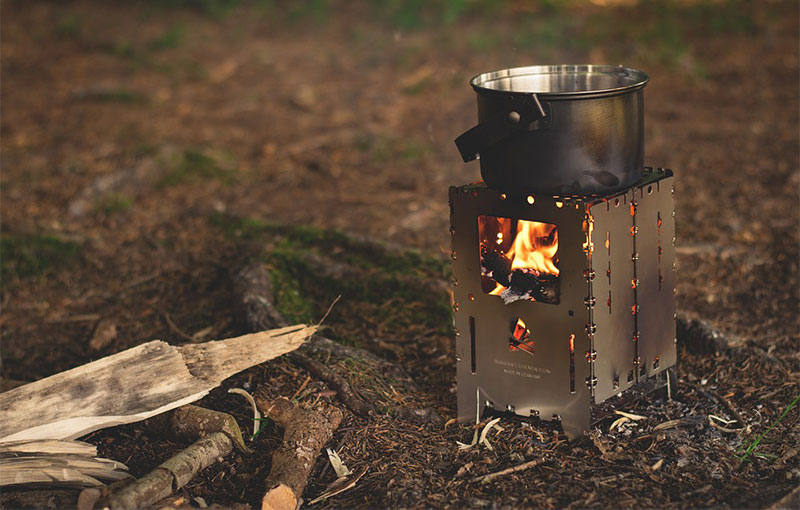
Bushbox Outdoor Pocket Stove
- Weight: 9.5 ounces
- Dimensions: 4.5” x 3.5” x 0.2” folded
- Type: Collapsible interlocking wood burning stove
- Boils Water in: 8 minutes and 25 seconds
Distinguishing Characteristics: The Bushbox Outdoor Pocket Stove is made of 100% stainless steel and manufactured in Germany. It fold up compact and packs flat enough to fit into a pocket. Two trivets fit on the top of the stove to support cooking vessels. The stove requires almost no care or maintenance other than keeping it free from dirt and wiping it down from time to time. An ash pan protects the soil beneath the stove from scorching. The stove will also work with a standard Trangia alcohol burner, Esbit and hexamine tablets or similar fuels. Compare to the Emberlit stove, above.
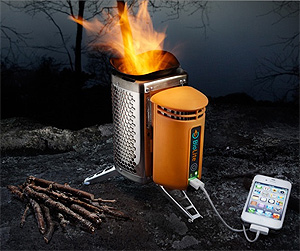
BioLite Wood Burning Camp Stove
- Weight: 2.1 pounds
- Dimensions: 5” x 5” x 8.3”
- Type: Cylindrical wood burning stove with power charger
Distinguishing Characteristics: The BioLite is part heat source, part stove and part off-grid charger. An automatic fan causes fuel to burn so completely that only a handful of ash remains. A screen surrounding the combustion chamber allows you to pick it up even when it’s hot.
While the BioLite qualifies as a wood burning backpacking stove, it does so just barely. It was not originally designed for that purpose. The 2-pound BioLite was originally conceived to be used in African villages where people were dying from waterborne diseases and needed a stove for boiling water that would burn fuels that would not normally be combustible. It will burn cherry pits and walnut shell, for example. The BioLite has two main parts: the combustion cylinder, where the fire burns, and a charger. Once the combustion cylinder warms up, a fan comes on that supplies air to the flame and causes it to burn hotter and at the same time charges the battery that runs the fan – a kind of “perpetual motion” stove. The increased heat also energizes the USB charger that will power a mobile device, although the amount of juice it supplies is small. The charger is rated at only 2 watts of 5 volt power, which translates into 15 minutes of burning adding a five percent charge to a mobile phone. The BioLite is also more expensive than other wood burning backpacking stoves. While it may not qualify as the most functional backpacking stove compared to others in this review, the BioLite is a fascinating novelty and a stove that functions well in the purpose for which it was originally designed.
Whatever wood burning backpacking stove you choose. you will find that as a category of stoves they are light, maintenance-free and easy to use. And they will add the magical element of fire to your backpacking and camping experience.
Related Post: Make your own backpacking stove

